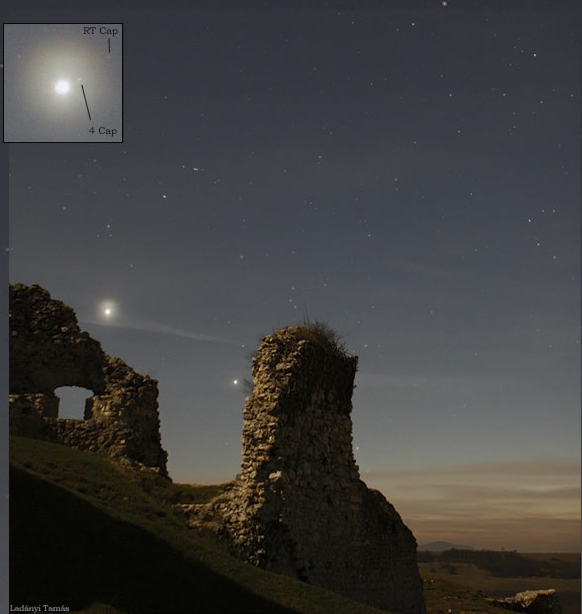Venus Corona
Exploring the Venus Corona Phenomenon
The Venus Corona is a captivating atmospheric optics phenomenon that occurs when Venus, the second planet from the Sun, is surrounded by a corona. This mesmerizing sight can be observed under specific atmospheric conditions, such as fogs, mists, and clouds. While coronae around the Moon are relatively common, witnessing one around a planet is considered rare due to their typically faint appearance.
The corona effect is created through diffraction, which is the bending and spreading of light waves as they encounter obstacles or small particles in the atmosphere. In the case of the Venus Corona, the diffraction occurs as light passes through small droplets present in the surrounding fog, mist, or cloud. These droplets act as miniature lenses, causing the light to scatter and create the stunning corona effect.
A noteworthy aspect of the Venus Corona phenomenon is the ability to estimate the size of the droplets responsible for the diffraction. By examining the angular size of the aureole red edge in relation to a nearby star, such as RT Capricorni in this particular image, it is possible to determine the approximate diameter of the droplets. In the case mentioned above, Mie scattering simulations conducted using IRIS software indicated that the droplet diameter was around 50 microns or 0.05 mm. This falls within the range of cloud droplet sizes, which typically range from 1 to 100 microns.
The rarity of observing a Venus Corona makes it a truly special phenomenon for atmospheric optics enthusiasts. The combination of favorable atmospheric conditions and precise alignment of celestial bodies is necessary for this spectacle to occur. When Venus and Jupiter align in conjunction over a moonlit landscape, as captured in the image from Szarvasko Castle, Hungary, the enchanting Venus Corona becomes visible.
To fully appreciate and understand the Venus Corona phenomenon, it is important to consider its underlying scientific principles. Here are some key points to consider:
- Coronae form through diffraction from small droplets in fogs, mists, and clouds.
- The corona effect is created when light waves encounter obstacles or small particles in the atmosphere.
- The Venus Corona is a rare occurrence due to its typically faint appearance.
- Observing a Venus Corona requires specific atmospheric conditions and precise alignment of celestial bodies.
- The size of the droplets responsible for the diffraction can be estimated by comparing the angular size of the aureole red edge with known reference points.
- Mie scattering simulations using specialized software, such as IRIS, aid in determining droplet sizes within the corona.
- The droplet diameter responsible for the Venus Corona captured in the image mentioned above was approximately 50 microns or 0.05 mm.
- Cloud droplets typically range in size from 1 to 100 microns, making the observed droplet diameter fall within this range.
- The Venus Corona is a captivating atmospheric optics phenomenon that adds a touch of magic to our celestial observations.
- Capturing images of the Venus Corona, such as the one taken by Tamas Ladanyi, allows us to appreciate the beauty and intricacies of our atmosphere.
In conclusion, the Venus Corona is a rare and stunning atmospheric optics phenomenon that occurs when Venus is surrounded by a corona. Understanding the scientific principles behind this phenomenon, such as diffraction and droplet size estimation, enhances our appreciation for its beauty. By capturing images like the one from Tamas Ladanyi, we can marvel at the intricate interplay between celestial bodies and our atmosphere. The Venus Corona serves as a reminder of the wonders that await us when we gaze skyward.

Venus Corona imaged December 9, '08 by Tamas Ladanyi (TWAN). ©Tamas Ladanyi, shown with permission.
Venus and Jupiter are in conjunction over the moonlit Szarvasko Castle, Hungary. Bright Venus, to the left, is enveloped in a corona.
Coronae form by diffraction from small droplets in fogs, mists and clouds. Those around the Moon are fairly common but ones around a planet are rare because they are usually too faint to perceive.
Here, we can even estimate the sizes of the droplets producing the diffraction. The star RT Capricorni was 0.81° from Venus, setting the angular size of the aureole red edge. Comparison with Mie scattering simulations in IRIS then give the droplet diameter as about 50 micron or 0.05 mm - at the upper end of the 1-100 micron range of cloud droplets.
Note: this article has been automatically converted from the old site and may not appear as intended. You can find the original article here.
Reference Atmospheric Optics
If you use any of the definitions, information, or data presented on Atmospheric Optics, please copy the link or reference below to properly credit us as the reference source. Thank you!
-
<a href="https://atoptics.co.uk/blog/venus-corona/">Venus Corona</a>
-
"Venus Corona". Atmospheric Optics. Accessed on November 14, 2024. https://atoptics.co.uk/blog/venus-corona/.
-
"Venus Corona". Atmospheric Optics, https://atoptics.co.uk/blog/venus-corona/. Accessed 14 November, 2024
-
Venus Corona. Atmospheric Optics. Retrieved from https://atoptics.co.uk/blog/venus-corona/.